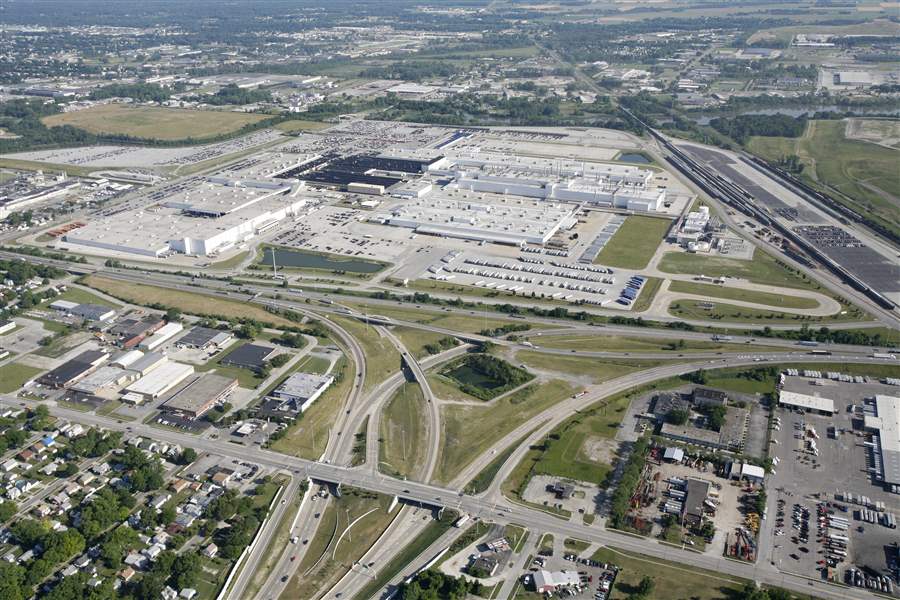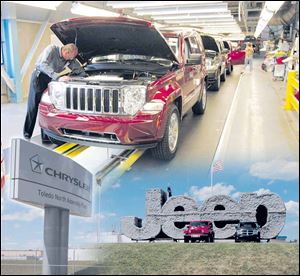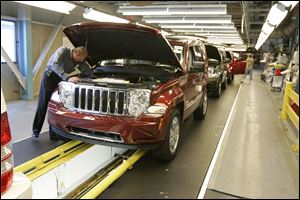
Jeep expansion to add 1,100 jobs
Chrysler plans initial investment of $365 million at Toledo complex
8/10/2011
Chrysler will invest $365 million in the Toledo Assembly Complex. Most of the funds will be used to retool and equip the facility. The company indicated it plans to build 327,000 vehicles at the modified Toledo North Plant, where Jeep Liberty and Dodge Nitro are built.
The Blade/Dave Zapotosky
Buy This Image

Toledo Assembly Complex currently builds the Jeep Liberty, top, and Dodge Nitro.
Chrysler Group LLC plans to invest at least $365 million to expand and improve its Toledo Assembly Complex, adding a second shift with 1,105 jobs to the plant that currently builds the Jeep Liberty and Dodge Nitro SUVs, The Blade has learned.
Analysts believe the investment could be the first of a number of expansions — and additional jobs — at the site in future years as the automaker ramps up production to meet global demand for up to seven different current and future vehicles, including the iconic Jeep Wrangler. While Chrysler’s current plans only list a second shift, a third shift at the Toledo North Plant could come if additional demand develops for new products, but that could be several years away.
Details of the automaker’s plans are contained in a city tax abatement application filed by Chrysler that is to be discussed at a meeting Thursday between the city and Toledo Public Schools.
WEB EXCLUSIVE: Explore the history of Jeep and Toledo with a special eBlade edition
RELATED ARTICLES: Hopefuls must apply for work online
The expansion will deliver a significant impact across a broad swath of the area economy: construction jobs for an $8 million expansion of the plant’s body shop, $357 million to retool and equip the complex, and a boost to the region’s manufacturing sector from added jobs by Chrysler and its many area suppliers.
“What we’ve learned, if nothing else, is that this will be a great day,” Toledo Mayor Mike Bell said.
Chrysler officially would not confirm the application’s details because a state incentive package is not finalized. But it gave The Blade this statement:
“In January, 2011, Chrysler Group CEO Sergio Marchionne confirmed that the company was considering a possible investment in its Toledo Assembly Complex. As part of the process, Chrysler Group is working with state and local governments to secure incentives that would support the business case for such an investment. However, any decision to invest in the Toledo facility would be contingent upon final approval of state and local incentives and final acceptance of all agreements by the company.”
Chrysler expects to complete its expansion by 2013, according to the application. It will add $36 million in payroll through 1,050 new production jobs at $14.65 per hour, and 55 management jobs at about $90,500 each annually.
Up to 7 vehicles
The automaker did not disclose what vehicles would be built in the modified plant, but indicated in earlier filings that it will build up to 327,000 vehicles per year at its Toledo North Plant. Ultimately, analysts said, the Toledo Assembly Complex, which includes the Wrangler plant, could build up to seven different vehicles, up from a current four, and have five — and possibly six — shifts of workers building new, more fuel-efficient, sport-utility vehicles and crossovers.
The complex’s two assembly plants, the Toledo North Plant that builds the Jeep Liberty and Dodge Nitro, and the Wrangler plant, which makes Jeep Wrangler and Wrangler Unlimited, now have one and two shifts, respectively. The plans revealed Thursday would restore a second shift at Toledo North plant for the first time since 2008.
“We’re very excited about this opportunity,” said Bruce Baumhower, president of United Auto Workers Local 12, which represents 2,500 hourly workers now at Chrysler’s Toledo Assembly Complex. “Our members at Chrysler have worked extremely hard for a very long time. They’ve fully embraced the World Class Manufacturing philosophy that Fiat introduced, and they’ve shown Chrysler why Toledo has the most productive work force in the country.”
Many of 1,050 production jobs will be filled, for the first time in years, from candidates “off the street.” New workers will be paid at a second-tier rate under the United Auto Workers contract that pays $14.65 an hour and is to be renegotiated this fall. Chrysler spokesman Jodi Tinson said the automaker has no laid-off hourly workers with recall rights nationally who could bump to the Toledo plant, although there are about 70 workers from Toledo North still laid off.
All hiring at the complex will be done through Chrysler’s Web site, Chryslercareers.com. But the company will not take applications for any new jobs until positions are posted at a later date, Ms. Tinson said.
Shipped overseas
Many of the products that will roll off local assembly lines will be shipped overseas as Chrysler and its Italian partner, Fiat SpA, leverage their worldwide dealer network to boost sales of Jeep — their most popular single brand, and the one most closely associated with the city of Toledo for the last 70 years.
New jobs likely will come to the complex in waves. First will be construction jobs as the automaker expands Toledo North’s body shop, adds an improved welding facility, and upgrades its existing body, trim, paint, and materials handling operations by adding equipment to improve productivity.
New production jobs will follow several months later with a second shift addition at Toledo North, which will build a successor to the Jeep Liberty, along with what could be three or more similar vehicles. As Chrysler adds its second shift of 1,050 jobs at Toledo North, several suppliers to the complex — including Johnson Controls Inc., Faurecia Inc., and Decoma Systems — are expected to boost production and jobs, enhancing the impact on the local economy.
A potential third shift could emerge if the automaker returns Toledo North to three shifts a day, a work level not seen since 2007.
Chrysler said in state filings that it expects Toledo North to produce up to 327,000 vehicles annually, compared to the plant’s 2010 production of 91,973 vehicles.
Not for Wrangler
The application with the city does not mention additional work at the complex’s Wrangler plant, which is struggling to meet demand for the iconic vehicle that had its highest-ever sales month in July.
Chrysler officials, including Jeep brand President Michael Manley and Mr. Marchionne, have expressed concern Wrangler demand could surpass the plant’s production capacity of about 155,000 vehicles per year, meaning further expansion could be forthcoming.
At 482,000 units a year, the Toledo Assembly complex could have a higher output than both Ford Motor Co.’s Kansas City Assembly Plant, which made 436,355 trucks and SUVs in 2010, and Volkswagen AG’s plant in Puebla, Mexico, which built 434,771 cars last year.
The world’s largest assembly plant is Hyundai’s complex in Ulsan, South Korea, which can produce up to 1.6 million vehicles a year.
Analysts associated with the Chrysler-centric Web site Allpar.com believe six or more vehicles soon will roll from the Toledo Assembly complex: two-door and four-door Wrangler models, a new Jeep Liberty, a Chrysler-badged crossover and a Lancia-badged version of the same vehicle for export, and a new Alfa Romeo SUV.
Economic impact
The automaker also has discussed producing a small Jeep-branded pickup, based on the Wrangler, that could be made in Toledo if the Wrangler plant is expanded. The information comes from long-term product plans released by both Chrysler and Fiat during the last several years.
Economists differ on estimates of the overall impact the jobs will have on the metro area’s economy.

An inspector examines the engine of Jeep Liberty as it goes through the certification line.
Some say that every job added at an auto plant results in between 4.7 and 10.6 jobs elsewhere in the local economy. Others argue that the true impact is smaller, citing the economic contraction that occurred when Toledo North lost its third and second shifts almost four years ago.
Whatever the impact, the announcement should provide the best chance in years to improve the situations for thousands of the region’s long-term unemployed.
“The rule of thumb is for every one [automaker assembly] job, you get 1.5 supplier jobs. And between them you get 4 more jobs beyond those [automaker] and supplier jobs,” said Debbie Menk, a labor specialist with the Center for Automotive Research, in Ann Arbor.
Chrysler’s new investment in Toledo — its third since 1997 — had many midwives to help it along:
The U.S. Department of Energy is close to reviewing a $3.5 billion “loan” to Chrysler to help offset retooling its plants to make more fuel-efficient vehicles. The $25 billion loan program for automakers with U.S. plants was approved by Congress in 2007 and repays automakers for funds expended to upgrade facilities to meet increasingly strict fuel-economy standards.
Ohio is offering tax incentives and training assistance, but will not confirm details of its incentive package until the Ohio Tax Credit Authority meets later this month.
Officials of the city of Toledo and local school districts worked to facilitate expansion of the city’s oldest and largest local manufacturer.
The federal government provided Chrysler with billions in loans — since fully repaid — in 2009 to see the then-struggling automaker through an expedited two-month bankruptcy process.
Italian automaker Fiat agreed to take over operation of Chrysler from its former owner, private equity firm Cerberus Capital Management, and launched a sweeping and unprecedented product renaissance in which it refreshed or improved 16 vehicles in an 18-month period. It returned the beleaguered domestic automaker to profitability for the first time in six years.
The United Auto Workers’ Voluntary Employee Beneficiary Association agreed to accept stock and other securities in place of cash to settle Chrysler’s outstanding retiree medical-benefits obligations, freeing the automaker’s books from billions in unpaid liabilities.
Concessions helped
Lastly, and perhaps most important, local Chrysler employees and their leadership within UAW Local 12 agreed to landmark job, pay, and work-rule concessions while increasing productivity, reducing absenteeism, and further improving performance at what had twice previously been named the most productive assembly plant in North America.
Mayor Bell said the city and local economic development teams offered Chrysler whatever assurances it needed to make the expansion happen.
“They weren’t really asking for anything that they didn’t already have, so we haven’t really had to give up anything,” Mr. Bell said. “I don’t think there were any holdups in the process. I think people really came together.”
U.S. Rep. Marcy Kaptur (D., Toledo) said Chrysler’s plans for its Toledo Assembly complex, along with more than $1 billion that General Motors Co. has invested in fuel-efficient products for its Toledo Powertrain Plant, position the region “to be the center of a new green automotive industry. As Chrysler and GM reposition, that repositions [Toledo] to compete in the global economy.”
She said she is confident federal, state, and local officials will “do what’s necessary to keep our economy growing” with incentive packages for the project.
Chrysler’s plans for its Toledo facilities have been under study since shortly after the automaker emerged from bankruptcy in June, 2009. But local elected and union officials say those plans changed many times in size and scope and were delayed repeatedly by industry and economic circumstances.
Originally, union officials said, Chrysler wanted to announce its plans for Toledo in September, 2009, but was delayed until that December while management worked feverishly on a comprehensive five-year global product and financial plan rolled out in November, 2009.
State held talks
When no announcement materialized by February, 2010, The Blade questioned Ohio Gov. Ted Strickland at a GM event in Defiance, where he admitted that the state had been in talks with Chrysler about a Toledo expansion.
At the time, analysts believed the automaker would consolidate several “D-segment” vehicles — the Toledo-made Jeep Liberty, the Chrysler Sebring and Sebring convertible, and the Dodge Avenger — in Toledo while preparing to close its Sterling Heights plant in suburban Detroit.
But last October, within nine months of Mr. Marchionne telling journalists at the North American International Auto Show in Detroit that there was “no way” Sterling Heights would remain open, Chrysler purchased the plant from its former bankrupt self.
It announced an $850 million investment to improve the plant’s capabilities and keep its high-volume passenger sedans in Michigan. Chrysler later added another production shift in Sterling Heights, Mich., leaving Toledo North as the only Chrysler assembly plant with just one shift.
As one of his first activities after being sworn into office in January, Ohio Gov. John Kasich became personally involved in efforts to bring additional work to Toledo’s Chrysler plants.
In addition to speaking with Chrysler representatives on the phone, the Republican governor traveled to Detroit during the auto show to meet with Chrysler’s top executives. That meeting included Ohio State University President E. Gordon Gee, University of Toledo President Lloyd Jacobs, Mr. Manley, and Toledo Assembly complex manager Mauro Pino.
Mayor Bell said Chrysler’s announcement, besides adding critically needed jobs to the local economy, likely will be a salve on Toledo’s recession-bruised psyche.
“We’re right now riding a pretty good wave in the city of Toledo, with all the positives that are going around in the city. When people start looking around and say, hey, this isn’t too bad at all, especially when you look at how other cities have been struggling to recover,” Mr. Bell said.